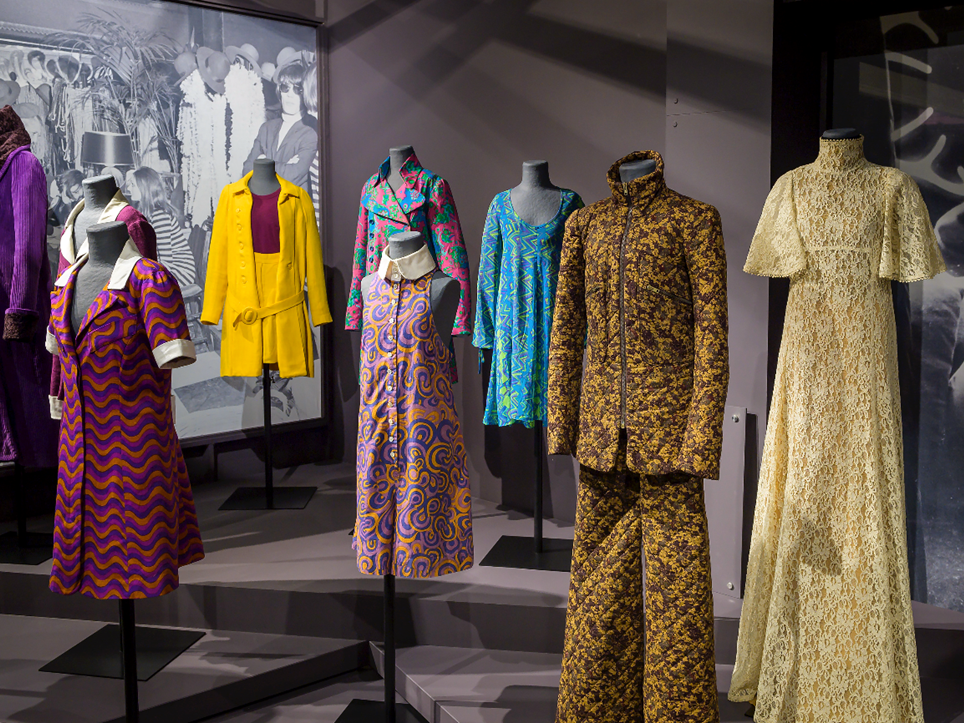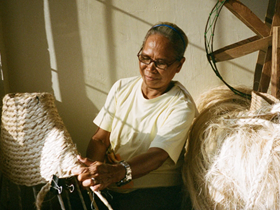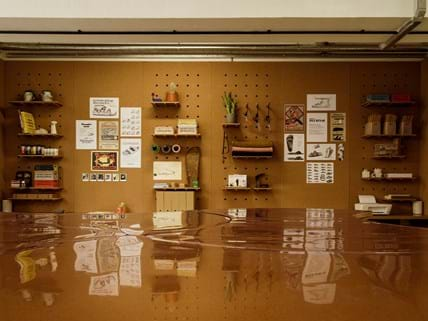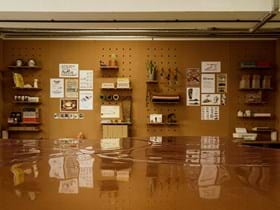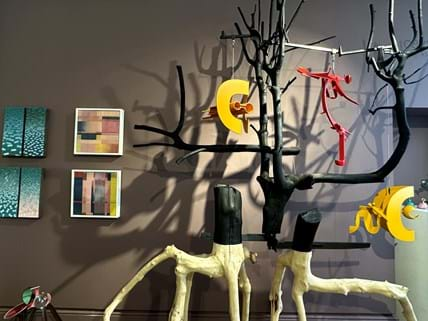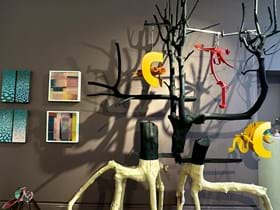As I left the Fashion and Textile Museum’s latest exhibition ‘The Biba Story’, I spied a queue of visitors, predominantly female, snaking their way down the street, waiting for their chance to enter. Witnessing this, I thought back to Martin Pel, the exhibition’s curator, describing the queues 50 years prior, of fashion forward young women, weaving their way down Kensington Church Street, waiting impatiently for their chance to step into the world of Biba. And yet, long after trading ceased, it’s evident that the draw of Biba is as omnipresent as it was when Barbara Hulanicki began building that world over 60 years ago.
Opening the exhibition is a replica of the iconic garment that shot Biba into the fashion stratosphere, a pink and white gingham shift dress designed by Hulanicki in 1963 that represented not only a turning point in her career, but a global fashion revolution. Prior to the arrival of this candy-coloured dress, shopping options for young women were few and far between. While Mary Quant had introduced a youthful and forward-thinking style in the early 1960s, her clothes were expensive and out of reach for many young working women. At a mere 25 shillings, Biba’s little pink and white dress both affordable and utterly stylish. Biba, which began as a humble mail order brand established by Hulanicki and her husband and business partner Stephen Fitz-Simon, quickly became big business, with over 17,000 orders.
With demand for more Biba creations high, Barbara and Fitz opened their first store in 1964. Traversing through to the main exhibition space, Biba’s retail reign is wonderfully illustrated across the various phases the brand navigated. Opening their first store in an old chemist on Abingdon Road, Biba’s world was decadent and ever-so slightly debaucherous. Feathered chandeliers and hat stands are adorned with piles of fabulous clothes, a sense of twilight-opulence hanging in the air. A spirit of optimism pervades the central room: the clothes were playful, with high-hemlines and billowing sleeves, representative of the modern young-woman.
While the pokey chemist served Biba’s London customers well, the demand for the brand grew and thus their store space did too. Moving to Kensington Church Street in 1966, the new Biba was four times the space of the original store and became a real community space for young women. With the first ever communal changing-room, Biba invited customers to treat shopping as an experience and not a chore. Bodacious prints in sumptuous jewel tones and glamorous two-piece sets defined Biba’s style during these years. The young Biba customer was growing up, and while still playful in her fashion, the new plunging necklines and the sexier silhouettes were indicative of Biba’s ability to evolve with their loyal customer base. From cutesy mini dresses appropriate for sitting on Brighton’s beach, to intricate lace gowns ready to walk down the church aisle, Barbara knew her customers wanted clothes for all phases of life and she managed to secure the status of being a brand for everyone.
After a few more shop openings, in 1973, taking up the prime location on High Street Kensington, Barbara and Fitz opened Big Biba. A seven-storey retail experience, Big Biba was an all-encompassing emporium, described by Time magazine in 1974 as “the most beautiful store in the world”. Home to Europe’s largest rooftop garden, multiple restaurants patronised by the likes of Twiggy and The Rolling Stones, Big Biba in all its bombastic glory sold everything from cans of turtle soup and Biba branded baked beans, to snow-leopard print suits and operatic sequined gowns. The lifestyle cornucopia was the first of its kind and became the blueprint for the plethora of famed retail institutions that would follow. However, the brightest flame burns the fastest and merely 2 years after opening, Big Biba shut its doors in 1975 with Barbara losing the rights to Biba shortly after.
You’d be forgiven for thinking that Biba’s odyssey-like story spanned multiple decades and many generations, and yet the brand had gone from mail order business to dominating the retail sphere to shutting down within only 12 years. With meticulous curation of dozens of archive Biba garments, from the famous black knee-high boots to untouched products from the makeup line, the exhibition wonderfully depicts the lifespan of a brand that would go on to change the world in just over a decade.
At the end of our tour, to our surprise, Barbara herself walked to the front of the room, charismatic, chic as ever and commanding the space with just her presence. Styled in all-black, with oversized sunglasses and a sharp blonde-bob, the room murmured with excitement. Upon being asked about her favourite Biba memory, Barbara, without hesitation, said it was the people that worked there. With a loud laugh, she recalled just how “frighteningly fun it all was”.
By Olivia Barrett
The Biba Story

